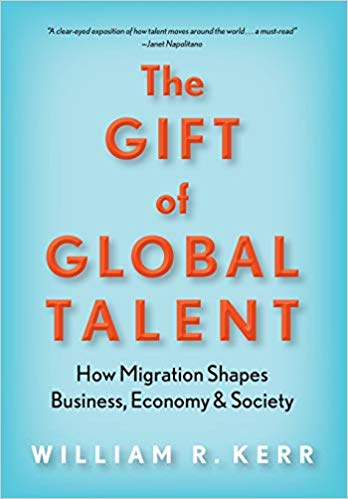You have /5 articles left.
Sign up for a free account or log in.
 The Gift of Global Talent: How Migration Shapes Business, Economy & Society by William R. Kerr
The Gift of Global Talent: How Migration Shapes Business, Economy & Society by William R. Kerr
Published in October 2018
You’ve probably heard the idea that data, not oil, is the most valuable resource of the 21st century.
If you read The Gift of Global Talent, and I think you should, you might conclude that skills are our most precious resource.
If you are convinced that economies, cultures and societies only advance through the work of humans -- then you are likely to become frustrated with the current status of U.S. immigration policy.
As The Gift of Global Talent amply documents, the U.S. continues to put up barriers that prevent the most skilled and educated individuals from working (and studying) in the U.S.
Other countries, such as Singapore and Canada and Australia and Sweden, have designed their immigration policies to attract skilled workers. The U.S., in contrast, continues to severely limit the number of H-1B visas that employers can sponsor. At the same time, it remains difficult for highly skilled international students who study and complete their educations in the U.S. to stay and work.
The Gift of Global Talent provides a deep dive into the economics of skilled immigration. Close followers of the technology industry will already be aware of migration as an engine for entrepreneurship.
Examples of tech companies founded or headed by immigrants or the children of immigrants include: Apple (Jobs was the son of a Syrian immigrant), Amazon (Bezos is second-generation Cuban), Google (Brin was born in Russia, CEO Sundar Pichai was born in India), Microsoft (CEO Satya Nadella was born in India), Tesla (Musk is South African born), Uber (Dara Khosrowshahi was born in Iran), Yahoo (Yang is from Taiwan), etc. etc. etc.
The chapter of The Gift of Global Talent that everyone in higher ed should read is chapter 5, “The Education Pathway.”
Some highlights:
- Over one million international students are studying at U.S. colleges and universities, accounting for about 5 percent of enrollment.
- Globally, 4.5 million students are studying at colleges and universities outside of their home country.
- The U.S. share of international students has been declining in recent years, due to stricter immigration policies and anti-immigrant rhetoric, and the investments of other nations (Australia, United Kingdom, etc.) to attract international students.
- The breakdown of non-U.S. citizens who study in the US is: 439,000 undergraduate students, 391,000 graduate students and 249,000 non-degree-seeking students. I don’t think that the above numbers include international students who study in low-residency or online programs, but I’m not sure. Do you know? The foreign student breakdown is from 2016 and is, therefore, before the massive growth in nondegree online programs from elite institutions.
- International students contribute over $37 billion each year to the U.S. economy.
- International students have become an essential element of the financial viability equation for many institutions, as international students do not benefit from in-state tuition or scholarships (tuition discounting).
One example that Kerr gives in The Gift of Global Talent is Fort Hays State University, located in rural Kansas. At FHSU, the undergraduate population is about 4,000 students, while the international enrollment at FHSU’s virtual campus is 6,000 students.
- In 2016, the top sending countries and regions to U.S. colleges and universities were China (33 percent), India (17 percent), Japan and Korea (7 percent), other Asian countries (12 percent), the Middle East and Africa (13 percent), Latin America (13 percent), and Europe/Canada/Mexico (13 percent). Does anyone have comparable data for country of origin for online (degree and nondegree) international students?
- In 2016, four in 10 new Ph.D. degrees in the U.S. were awarded to international students.
Care to share some other eye-opening statistics about the integration of the U.S. postsecondary ecosystem into the global economy?
It is hard to read The Gift of Global Talent without wondering if the leaders of American colleges and universities are doing enough to advocate for sensible immigration policies.
The Gift of Global Talent does an excellent job of recognizing the costs as well as the benefits of immigration. For low-skilled jobs, a greater supply of workers can drive down wages and employment for native-born workers.
When it comes to highly skilled people, however, the evidence that the U.S. benefits from having the most educated and ambitious live and work in the U.S. is overwhelming.
What is the story of international students, and foreign-born faculty, on your campus?
What books on immigration would you recommend?
What are you reading?




